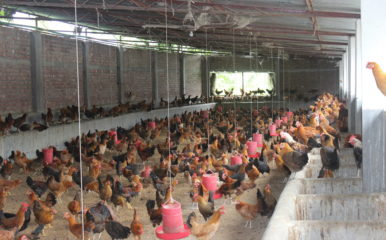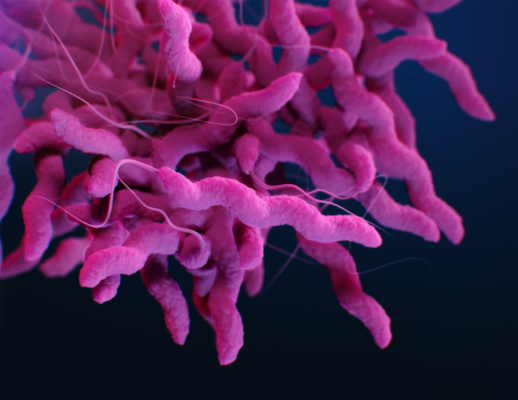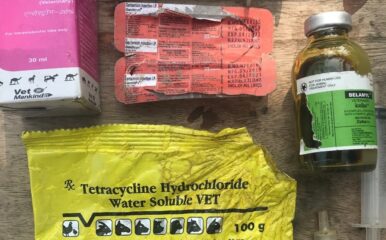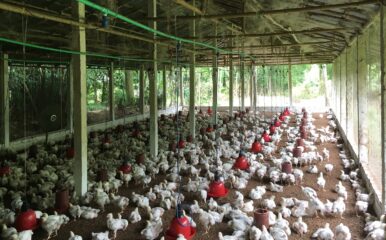
Campylobacter: a foodborne pathogen that can kill
Published on 08/09/2022

Medical Illustrator: Alissa Eckert
 This blog focuses on the ZOODLE word ‘CAMPY’.
This blog focuses on the ZOODLE word ‘CAMPY’.
Campylobacter – known by those like myself who work on it everyday as ‘Campy’ – is a motile bacterium. By that, we mean it is a tiny, single-celled organism that can move. Under the microscope it often looks like a helical worm with a long thin tail (its ‘flagella’).
It is one of the four most common causes of diarrhoeal disease in people.
The illness it can cause, campylobacteriosis, normally gets better of itself with no long-term effects. However, severe diarrhoea in low-income countries can result in death, especially in the elderly, immune-suppressed and in children. Campylobacter infection also occasionally causes serious complications, such as irritable bowel syndrome, temporary paralysis, arthritis and Guillain-Barré syndrome, a rare condition in which a person’s immune system is triggered by an infection that leads to muscle weakness or sometimes paralysis.
Antimicrobial resistance
In addition, because it is gram-negative, it can easily acquire and spread resistance strains to multiple antimicrobial drugs. Although infection with Campylobacter is generally self-limiting in people, and treatment is not given, those with underlying health conditions or otherwise vulnerable may be prescribed antibiotics, the most common being fluoroquinolones and macrolides. These drugs are also commonly used in agricultural practices, with strong evidence that this combination has led to the emergence of antimicrobial resistant Campylobacter strains. With a rise in antimicrobial resistance (AMR), the treatment of Campylobacter is becoming more difficult.
All this means that Campylobacter is viewed as an important public health hazard by the World Health Organization (WHO).
Risk factors
Eating highly contaminated and undercooked or raw poultry is a major risk factor for becoming ill with Campylobacter. Beef, offal and other meat products can also be contaminated during processing or from unhygienic practices.
Campylobacteriosis also follows a seasonal pattern, with more cases occurring during the summer months than in the winter. Other factors, such as international travel and exposure to animals in the food chain by e.g., farmers, have also been highlighted with altered risk of Campylobacter infection.
Research into the poultry production and distribution network in resource-limited countries is important as it can identify the risk factors associated with the sources of Campylobacter and suggest preventive measures to safeguard public health from this zoonotic pathogen.
Surveillance
The large scale of human disease globally since Campylobacter’s discovery in the 1970s has led to the development of many surveillance programmes to track the origin and spread of Campylobacter, particularly in developed countries. By understanding the transmission route of the bacteria from ‘farm to fork’ and what is likely to increase the risk of contamination in the food chain, better intervention methods can be proposed and tested with the aim of reducing infections in people.
Improved hygiene processes during slaughter, meat processing and packaging, as well as at retail, are all areas which can be improved upon.
Sourcing outbreaks
There are two primary species of Campylobacter which cause clinical disease, C. jejuni and C. coli. Typing of Campylobacter has traditionally been used to differentiate the species, as well as to attribute the primary source of infection, i.e., if the infection was likely to occur from a chicken over a pig or cattle source.
From this, outbreaks can be monitored, and associations made to understand the bacteria’s spread, a combination of which can be used to mitigate and control infections.
Our research
The Hub has been supporting research activities to identify the risk association of Campylobacter across poultry production and distribution networks in Bangladesh, India and Vietnam, and the public health impacts attributed to such risk-linkage. This effort will not only generate baseline information on the public health impact of poultry-borne Campylobacter, but also be the first step to introducing a One Health surveillance for this important zoonotic pathogen in South and Southeast Asian countries.
Collaboration between scientists in our study countries and those in UK institutions will further help detail genetic information of strains of the pathogen circulating in South and Southeast Asia, along with their antimicrobial resistance profiles. Such collaboration will further support the development of preventive strategies to reduce the risk of campylobacteriosis in people by addressing the poultry-borne risks identified, and potentially via vaccine development too.


